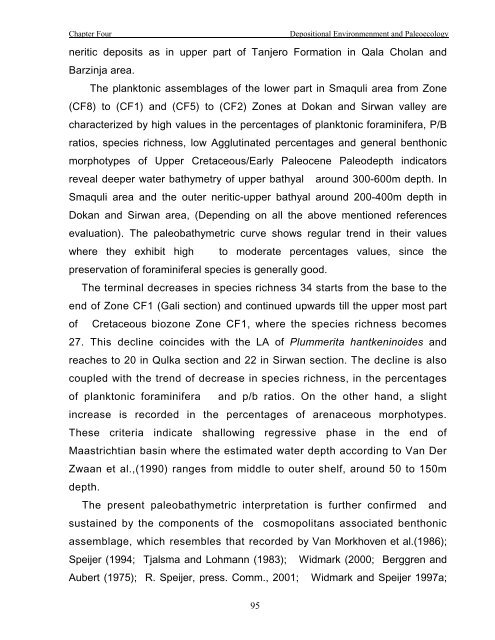biostratigraphy and paleoecology of cretaceous/tertiary boundary in ...
biostratigraphy and paleoecology of cretaceous/tertiary boundary in ...
biostratigraphy and paleoecology of cretaceous/tertiary boundary in ...
Create successful ePaper yourself
Turn your PDF publications into a flip-book with our unique Google optimized e-Paper software.
Chapter Four<br />
Depositional Environmenment <strong>and</strong> Paleoecology<br />
neritic deposits as <strong>in</strong> upper part <strong>of</strong> Tanjero Formation <strong>in</strong> Qala Cholan <strong>and</strong><br />
Barz<strong>in</strong>ja area.<br />
The planktonic assemblages <strong>of</strong> the lower part <strong>in</strong> Smaquli area from Zone<br />
(CF8) to (CF1) <strong>and</strong> (CF5) to (CF2) Zones at Dokan <strong>and</strong> Sirwan valley are<br />
characterized by high values <strong>in</strong> the percentages <strong>of</strong> planktonic foram<strong>in</strong>ifera, P/B<br />
ratios, species richness, low Agglut<strong>in</strong>ated percentages <strong>and</strong> general benthonic<br />
morphotypes <strong>of</strong> Upper Cretaceous/Early Paleocene Paleodepth <strong>in</strong>dicators<br />
reveal deeper water bathymetry <strong>of</strong> upper bathyal around 300-600m depth. In<br />
Smaquli area <strong>and</strong> the outer neritic-upper bathyal around 200-400m depth <strong>in</strong><br />
Dokan <strong>and</strong> Sirwan area, (Depend<strong>in</strong>g on all the above mentioned references<br />
evaluation). The paleobathymetric curve shows regular trend <strong>in</strong> their values<br />
where they exhibit high to moderate percentages values, s<strong>in</strong>ce the<br />
preservation <strong>of</strong> foram<strong>in</strong>iferal species is generally good.<br />
The term<strong>in</strong>al decreases <strong>in</strong> species richness 34 starts from the base to the<br />
end <strong>of</strong> Zone CF1 (Gali section) <strong>and</strong> cont<strong>in</strong>ued upwards till the upper most part<br />
<strong>of</strong> Cretaceous biozone Zone CF1, where the species richness becomes<br />
27. This decl<strong>in</strong>e co<strong>in</strong>cides with the LA <strong>of</strong> Plummerita hantken<strong>in</strong>oides <strong>and</strong><br />
reaches to 20 <strong>in</strong> Qulka section <strong>and</strong> 22 <strong>in</strong> Sirwan section. The decl<strong>in</strong>e is also<br />
coupled with the trend <strong>of</strong> decrease <strong>in</strong> species richness, <strong>in</strong> the percentages<br />
<strong>of</strong> planktonic foram<strong>in</strong>ifera <strong>and</strong> p/b ratios. On the other h<strong>and</strong>, a slight<br />
<strong>in</strong>crease is recorded <strong>in</strong> the percentages <strong>of</strong> arenaceous morphotypes.<br />
These criteria <strong>in</strong>dicate shallow<strong>in</strong>g regressive phase <strong>in</strong> the end <strong>of</strong><br />
Maastrichtian bas<strong>in</strong> where the estimated water depth accord<strong>in</strong>g to Van Der<br />
Zwaan et al.,(1990) ranges from middle to outer shelf, around 50 to 150m<br />
depth.<br />
The present paleobathymetric <strong>in</strong>terpretation is further confirmed <strong>and</strong><br />
susta<strong>in</strong>ed by the components <strong>of</strong> the cosmopolitans associated benthonic<br />
assemblage, which resembles that recorded by Van Morkhoven et al.(1986);<br />
Speijer (1994; Tjalsma <strong>and</strong> Lohmann (1983); Widmark (2000; Berggren <strong>and</strong><br />
Aubert (1975); R. Speijer, press. Comm., 2001; Widmark <strong>and</strong> Speijer 1997a;<br />
95

















